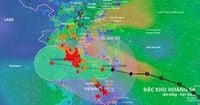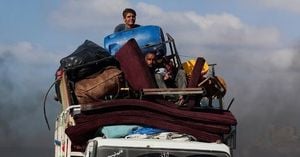As Typhoon Nongfa — officially designated Typhoon No. 6 — barrels toward the central coast of Vietnam, authorities across the region are scrambling to protect lives and property before the storm’s arrival. With the typhoon forecasted to make landfall on the evening of August 30, 2025, in Hà Tĩnh and Bắc Quảng Trị provinces, the government’s response has been swift and comprehensive, reflecting both the urgency of the situation and the painful memory of recent storms that have battered the region.
Forecasts from the Meteorological and Hydrological Station of Nghệ An province, cited by Tuổi Trẻ, warn of heavy rain and rapidly intensifying winds along the Nghệ An coastline, including Hòn Ngư island. Winds are expected to reach levels 6-7, with the storm center passing through at a formidable level 8 and gusts up to level 10. Waves could tower between 2.0 and 5.0 meters, making the sea extremely dangerous for any vessel.
In anticipation, local authorities have wasted no time. At 10:00 AM on August 30, Nghệ An province officially banned all boats and transport vehicles from venturing offshore. Any vessels still at sea were ordered to return and moor safely by 3:00 PM the same day. Officials have been using every available means to notify boats of the approaching storm, urging them to seek shelter or escape the danger zone altogether. As a further precaution, guidance has been provided for mooring boats at safe havens, including instructions for fish farming cages and floating houses to be secured against the coming winds and waves.
The timing of Typhoon Nongfa’s arrival could hardly be worse. The storm is expected to hit during the National Day holiday weekend, a period when many people are traveling or preparing for celebrations. According to Dân Trí, this coincidence is causing added anxiety, as the region is also still reeling from the effects of Typhoon No. 5, which recently brought storms, rain, and flooding to the same provinces now in Nongfa’s crosshairs.
Rainfall predictions paint a daunting picture. From the afternoon of August 30 through the night of August 31, Nghệ An province is expected to see heavy to very heavy rain. Mountainous areas could receive 100-150mm, with some places like Quế Phong, Quỳ Châu, and Quỳ Hợp likely to surpass 200mm. The midlands and coastal plains are forecasted to see 100-200mm, with some locations — Cửa Lò, Trường Vinh, Hưng Nguyên, Sơn Lâm, and Đô Lương — possibly exceeding 300mm. The risk of flash floods, landslides in mountainous areas, and widespread flooding in lowlands, riversides, and urban zones is described as very high.
Recognizing the severity of the threat, Vietnam’s central government has taken decisive action. On August 30, Deputy Prime Minister Trần Hồng Hà signed urgent dispatch No. 153 on behalf of the Prime Minister, ordering a concentrated response to Typhoon No. 6. The directive, as reported by CafeBiz and Dân Trí, calls on local authorities in Thanh Hóa, Nghệ An, Hà Tĩnh, Quảng Trị, and Huế to monitor the storm closely, provide continuous updates, and disseminate information rapidly to ensure everyone is prepared.
“Determination not to leave people on boats, fish cages, or aquaculture houses during the typhoon’s direct impact,” the Prime Minister emphasized in the dispatch, underscoring the government’s resolve to prevent loss of life. Localities have been instructed to inspect and count all boats and vessels at sea, ensuring that everyone is accounted for and informed about the typhoon’s progress. Authorities are also charged with arranging forces and equipment to support the evacuation and relocation of residents living in unsafe areas — particularly those in weak houses, lowlands, or locations prone to landslides and flooding.
The government’s approach is both comprehensive and pragmatic. Emergency response plans for floods, landslides, and flash floods have been activated according to the “4 on the spot” principle: on-site command, on-site forces, on-site supplies, and on-site logistics. This strategy, described by Tuổi Trẻ, aims to ensure that help is available where and when it’s needed most, even if roads become impassable or communication is disrupted.
Coordination between ministries is another key aspect of the response. The Ministry of Agriculture and Environment has been tasked with closely monitoring the typhoon and providing timely, accurate information about its development. The Ministry of Industry and Trade is responsible for ensuring the safety of hydropower reservoirs and the electricity grid, while also making contingency plans for supply disruptions in areas likely to be cut off by flooding or landslides. The Ministry of Defense and the Ministry of Public Security are readying rescue teams and equipment, prepared to assist localities that may become isolated by the storm’s impact.
“Local authorities are required to monitor, update continuously, and disseminate information about the typhoon and floods to proactively direct response work,” Dân Trí reported, summarizing the government’s expectations for vigilance and rapid communication.
On the ground, the mood is a mixture of apprehension and determination. In coastal villages, border guards and local officials are working side by side, helping fishermen secure their boats and guiding them to safe mooring spots. Fish farmers are racing to reinforce cages and floating houses, hoping their preparations will hold against the typhoon’s fury. In towns and cities, emergency shelters are being readied, and volunteers are standing by to assist with evacuations if needed.
But there’s also frustration — and a sense of déjà vu. Many residents have barely recovered from the last storm, and now they find themselves once again bracing for nature’s onslaught. The memory of previous floods and landslides is still raw, and the prospect of another disaster so soon has left some feeling anxious and weary.
Nevertheless, there’s a strong sense of solidarity and shared purpose. The government’s message is clear: every life counts, and every precaution must be taken. From the highest levels in Hanoi to the smallest fishing hamlets along the coast, the focus is on preparation, communication, and mutual support.
As Typhoon Nongfa bears down on central Vietnam, the nation is mobilizing all available resources to confront the storm head-on. The coming hours will test both the strength of Vietnam’s emergency response system and the resilience of its people. For now, all eyes are on the sky — and on the rising winds and waves that signal the typhoon’s imminent arrival.




